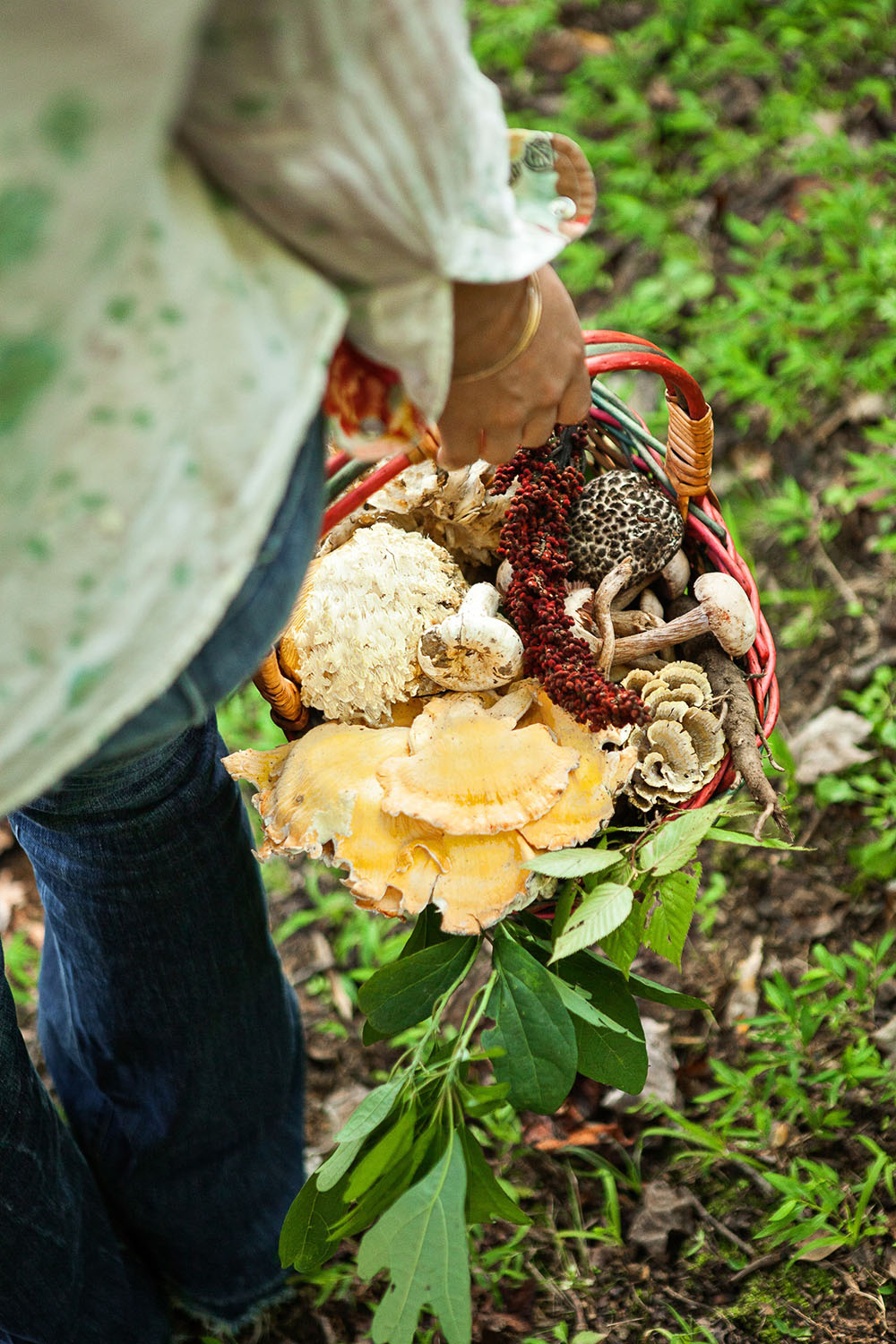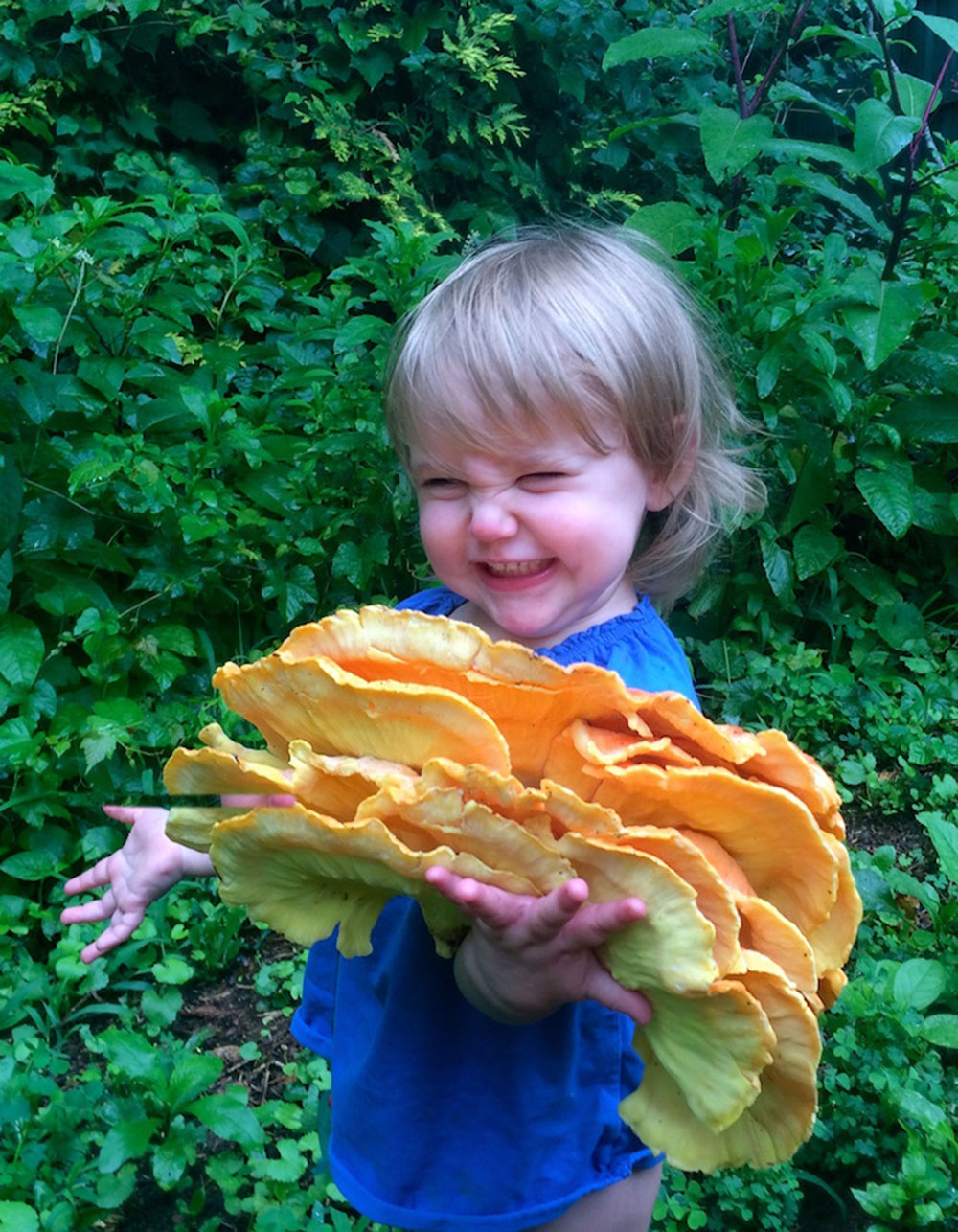
Mixed basket. Photo courtesy of No Taste Like Home
By Kayla Bott
Fungi comprise one of the largest and most diverse kingdoms of life. More extensive than even flowering plants, perhaps only a tenth of living fungi species are so far known. Their roles in decomposition, plant nutrition, the carbon cycle and other natural processes are crucial to life as we know it on this planet. Our mountains house a rich diversity of fungi, some of which produce abundant fruits that are naturally healthy and delicious.
“There’s nothing quite like foraging the Appalachians in June,” says Kenny Rupert, owner of Fun Guy Foraging. “Nettles biting at your ankles, balanced by the sweet smell of honeysuckle, make the pursuit of beautiful mushrooms like reishi, chicken of the woods and (hopefully) the first chanterelles of the season that much sweeter.”
Rupert leads area hikes through No Place Like Home, an Asheville-based tour company that is the only one in North America so far offering “forage-totable” tours for individuals, families and restaurants. Founded by Alan Muskat, the business is well known for its friendly, knowledgeable staff, with more than 20 years’ experience harvesting more than 100 edible wild plants and mushrooms growing freely in Western North Carolina.
Foraging is an exciting and rewarding hobby that requires dedicated study to practice safely. Joining your local mushroom club, attending guided hikes, spending time with experienced foragers and focusing on easily identifiable species are all ways of building a knowledge base and support system.
“What mycophiles call the ‘foolproof four’ are perfect for beginners,” says Rupert, “chicken of the woods, puffballs, morels and chanterelles.” These species are recommended because they tend to be readily identifiable with few to no look alikes. Even so, one must always take precautions; chicken of the woods growing on conifers (which can carry toxins), false morels and other potential hazards can still occur for the inexperienced gatherer.
A proper toolkit is another necessity for fungal study, as measurements, samples and detailed notes are vital for proper identification. Isolate specimens into wax or paper bags in a breathable, stiff container such as a wicker basket. A field guide, experienced friends and a few encounters with the same species will acclimate you to recognizing mushrooms as easily as you now distinguish different types of lettuces, tomatoes and other vegetables. If this seems too tedious for your taste, there is a simpler way to reap the benefits of mushrooms.
“There are about 50 varieties currently available for log cultivation and I have cultivated 27 of them over the last few years,” says Alexis Beresford, West-Asheville resident and dedicated mycophile with more than a decade of foraging experience. “I’ve recently been experimenting with mulch inoculation, which will expand that variety to nearly 100 species.” Packed with proteins, vitamins, iron and other beneficial metals, homegrown mushrooms are an inexpensive supplement to any diet.

Chicken of the woods. Photo courtesy of No Taste Like Home
The cultivation of species other than portobello is relatively new, with research and farming attempts expanding immensely over the last decade. Professional assistance from mycological suppliers such as Asheville Fungi continue to simplify the process of growing these delicacies.
“It’s a surprisingly inexpensive hobby; around $30 typically supplies enough for ten logs (oyster, shiitake and reishi varieties are reliable delicacies to start with) which will fruit for up to a year for each inch in diameter,” says Beresford. “Pick an area of your property where almost nothing else will grow due to sogginess or deep shade and mushrooms will occupy it happily.”
Find some hardwood logs and inoculate using a properly sized drill bit, mushroom dowel spawn and a wax seal over the holes and wait. Leave them in a shady spot making sure they get damp, and they will be fruiting in no time. New logs take about a year to start, but in maturity will fruit annually. You can even purchase fully inoculated logs that are ready to produce at Asheville Fungi and local mushroom farms.
“The pollinating ants cultivate the reishis, while the worms bore holes in the wood, allowing beneficial insects to enter,” says Beresford. “The stumps will inoculate all the way down to their roots, breaking down massive tree remnants into mushroom compost, which continues to feed the fruit trees and berry bushes that supply us, along with the mushrooms. It’s a pleasure to witness the cycle of life in your own backyard.”
For information about foraging tours with No Taste Like Home, visit notastelikehome.org or call 828.209.8599. Kenny Rupert’s Fun Guy Foraging Company can be found on Facebook. For supplies and assistance with home cultivation, contact Asheville Fungi at ashevillefungi.com, call 855.55.FUNGI or visit their location at 16 Allen Street. Explore events and membership opportunities with Asheville Mushroom Club at ashevillemushroomclub.com. Read Alexis Beresford’s Mushroom Journal at mushroomsofasheville.blogspot.com.






